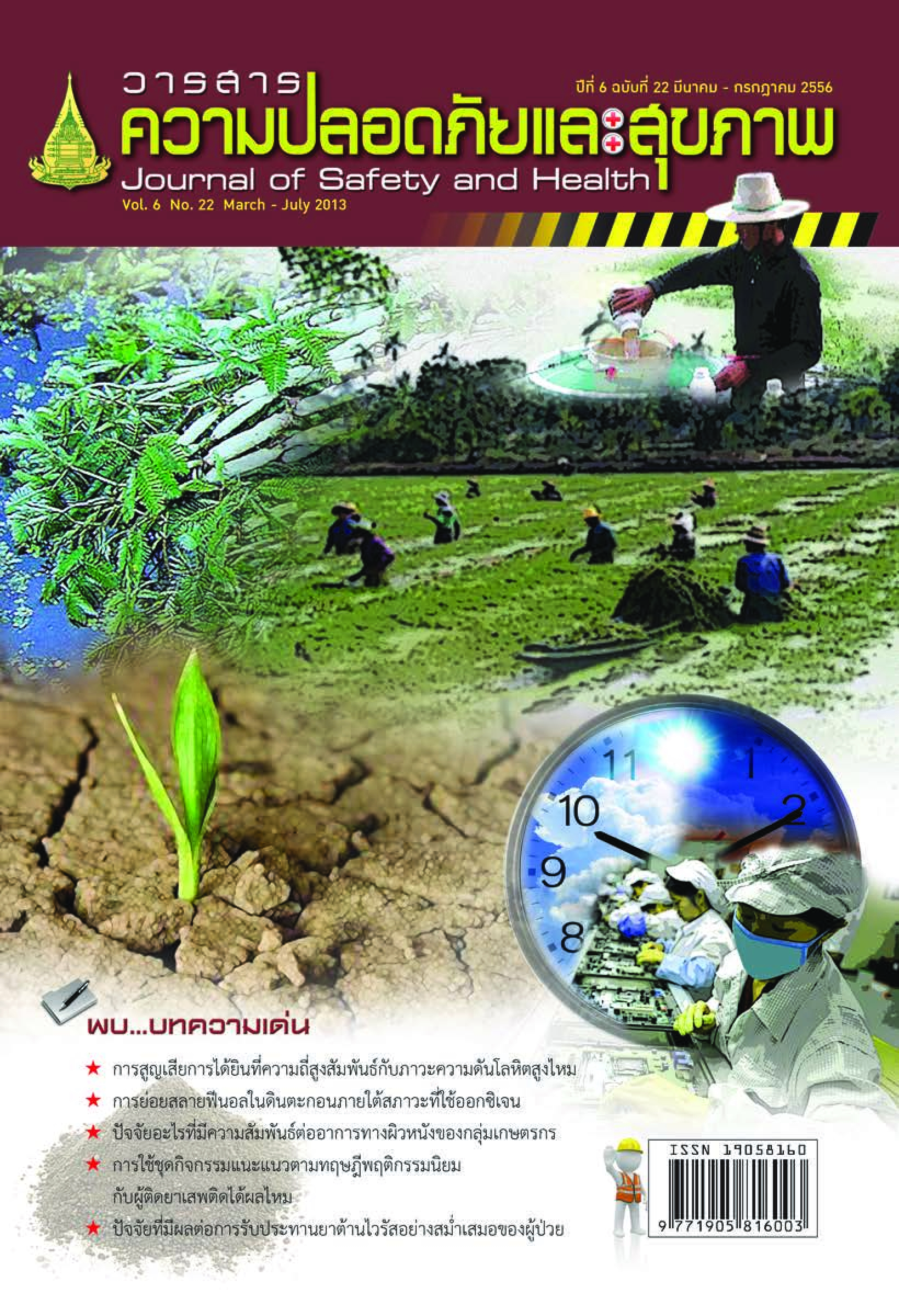การย่อยสลายฟีนอลในดินตะกอนภายใต้สภาวะที่ใช้ออกซิเจน
Main Article Content
บทคัดย่อ
ในการศึกษาครั้งนี้ศึกษาถึงการย่อยสลายฟีนอลภาย ใต้สภาวะที่ใช้ออกซิเจนด้วยสารละลายดินตะกอนจากนาข้าว ซึ่งพบว่า มีการปนเปื้อนด้วยไนเทรต (0.031 มิลลิโมลาร์) ไนไทรต์ (0.028 มิลลิโมลาร์) แต่ไม่ปนเปื้อนด้วยฟีนอลและ สารพาราไฮดรอกซีเบนโซเอต เมื่อทำ การเติมฟีนอลความ เข้มข้น 0.1 มิลลิโมลาร์ ที่เติมครั้งแรก (วันที่ 0) และครั้งที่ 2 (วันที่ 6) ลงไปในชุดทดลองผลการศึกษาพบว่าจุลินทรีย์ ในสารละลายดินตะกอนสามารถย่อยสลายฟีนอลได้หมด ภายในเวลา 2 วันเท่ากัน ส่วนเมื่อเติมฟีนอลความเข้มข้น 0.3 มิลลิโมลาร์ พบว่า เกิดการย่อยสลายจนหมดภายใน ระยะเวลา 5 วัน นอกจากนั้นยังพบการเกิดก๊าซในชุดทดลอง เมื่อเติมฟีนอลความเข้มข้น 0.1 มิลลิโมลาร์ ในครั้งแรกใน วันที่ 1 ของการทดลอง และลดลงตามระยะเวลาของการ ทดลอง และเมื่อทำ การคัดแยกจุลินทรีย์ในดินตะกอนจาก ชุดทดลองคือ Bacillus sp.
Article Details

อนุญาตภายใต้เงื่อนไข Creative Commons Attribution-NonCommercial-NoDerivatives 4.0 International License.
Journal of Safety and Health is licensed under a Creative Commons Attribution-NonCommercial-NoDerivatives 4.0 International (CC BY-NC-ND 4.0) licence, unless otherwise stated.
เอกสารอ้างอิง
บัญญัติ สุขศรีงาม (2534) จุลชีววิทยาทั่วไป. กรุงเทพฯ: โอ. เอส. พริ้นติ้ง เฮ้าส์.
มนัส สุวรรณ (2532) นิเวศวิทยากับการพัฒนาเศรษฐกิจ. กรุงเทพฯ: โอเดียนสโตร์.
สมศักดิ์ วังใน (2528) จุลินทรีย์และกิจกรรมในดิน. กรุงเทพฯ: ไทยวัฒนาพานิชจำ กัด.
สุบัณฑิต นิ่มรัตน์ และสุกานดา เกื้อกิจกูล (2546) การย่อย สลาย p-Hydroxybenzoate โดยใช้ mixed culture ภายใต้สภาวะที่มีออกซิเจน. ใน การประชุมวิชาการ ครั้งที่ 41 มหาวิทยาลัยเกษตรศาสตร์ กรุงเทพฯ วันที่ 3 - 5 กุมภาพันธ์ 2546.
Association of Official American Chemists [AOAC]. (2002). Official methods of analysis. Association of Official American Chemists, MD.
Basha, K.M., Rajendran, A. & Thangavelu, V. (2010). Recent advances in the biodegradation of phenol: A review. Asian Journal of Experimental Biological Sciences, 1 (2), 219 - 234.
Bayly, R.C. & Wigmore, G.J. (1973). Metabolism of phenol and cresols by mutants of Pseudomonas putida. Journal of Bacteriology, 113 (3), 1112 - 1120.
Bertani, I., Kojic, M. & Venturi, V. (2001). Regulation of the p-hydroxybenzoic acid hydroxylase gene (pobA) in plant-growth-promoting Pseudomonas putida WC358. Microbiology, 147, 1611 - 1620.
Cavallo, R.S. & Stabili, L. (2002). Presence of vibrios in seawater and Mytilus alloprovincialis (Lam.) from the Mar Piccolo of Toranto (Ionian Sea). Water Research, 36, 3719 - 3726.
Cerniglia, C.E. (1992). Biodegradation of polycyclic aromatic hydrocarbons. Biodegradation, 3, 351 - 368.
Healy, J.B. & Young, L.Y. (1979). Anaerobic biodegradation of eleven aromatic compounds to methane. Applied and Environmental Microbiology, 38 (1), 84 - 89.
Holt, J.G., Krieg, N.R., Sneath, P.H.A., Staley, J.T. & Williams, S.T. (1994). Bergey’s Manual of Systematic Bacteriology, Vol.1. Baltimore: Williams & Wilkins.
Krieg, N.R. & Holt, J.G. (1984). Bergey’s Manual of Systematic Bacteriology, Vol.1. Baltimore: Williams & Wilkins.
Mutzel, A., Reinscheid, U.M., Antranikian, G. & Muller, R. (1996). Isolation and characterization of a thermophilic bacillus strain, that degrades phenol and cresol as sole carbon source at 70 0 C. Applied Microbiol Biotechnol, 46, 593 - 596.
Nair, C.I., Jayachadran, K. & Shashidhar, S. (2008). Biodegradation of phenol. African Journal of Biotechnilogy, 7 (25), 4951 - 4958.
Nimrat, S. (2000). Biodegradation of methyl parathion, p-nitrophenol and p-aminophenol under anoxic conditions (Ph.D. in Environmental Sciences), Department of Enviromental Science, Retgers, TheState University of New Jersey, New Brunswich, USA.
Stickland, J.D.H. & Parson, T.R. (1972). A practical handbook of seawater analysis (2nd ed.). Ottawa: Fisheries Research Board of Canada Bulletin.
Stabili, L., Acquaviva, M. & Cavallo, R.A. (2005). Mytilis alloprovincialis filter feeding on the bacterial community in Mediterranean area (Northern Ionian Sea, Italy). Water Research, 36, 469 - 477.
Trabue, S.L., Ogram, A.V. & Ou, L.T. (2001). Dynamics of carbofuran-degrading microbial communities in soil during three successive annual applications of carbofuran. Soil Biology & Biochemistry, 33, 75 - 81.
Van Schie, P.M. & Young, L.Y. (1998). Isolation and characterization of phenol-degrading denitrifying bacteria. Applied and Environmental Microbiology, 64 (7), 2432 - 243.
Zhang, X. & Wiegel, J. (1994). Reversible conversion of 4-hydroxybenzoate and phenol by Clostridium hydroxybenzoicum. Applied and Environmental Microbiology, 60 (11), 4128 - 4185.


